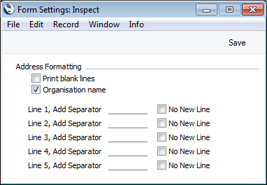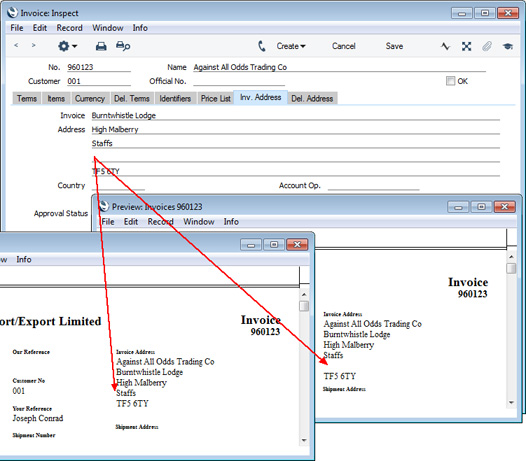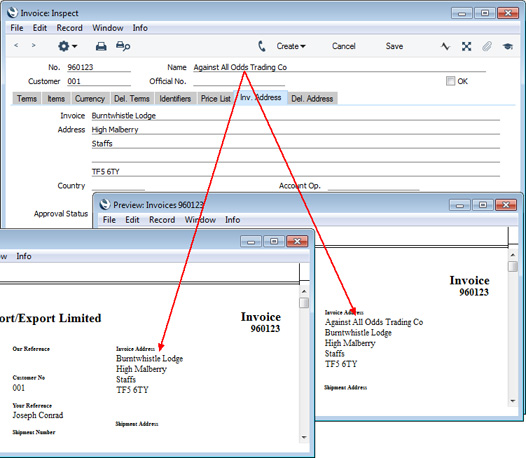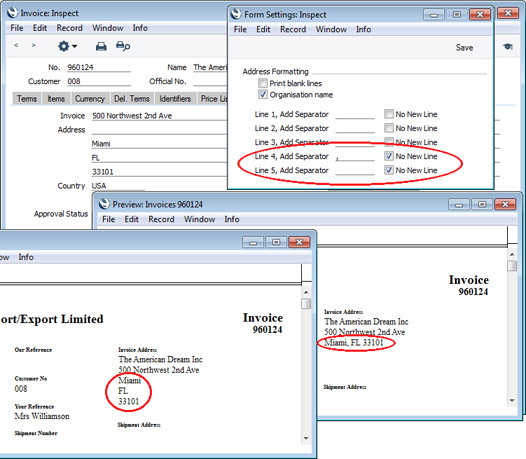Form Settings
This page describes the Form Settings setting in the System module.
---
The Form Settings setting allows you to control how addresses will be printed in forms. The setting affects the following form fields in most (but not all) forms: "Address"; "Address with Attention" (only when printed from Reservations); "Delivery Address"; "Delivery Address 2" (only when printed from Orders); "From Address"; "Invoice Address"; "Invoice To Address"; "Invoice To, jewellery"; "Location Address"; "Order Address"; "Order Delivery Address"; "Ordering Customer Name and Address"; "Own Address"; "Own Address 2"; "Premise Address"; "Shipment Address"; "Shipment Address 2"; "To Address" and "Via Location Address".
To open the Forms Setting setting, first ensure you are in the System module. Then, if you are using Windows or Mac OS X, click the [Settings] button in the Navigation Centre and double-click 'Form Settings' in the 'Settings' list. If you are using iOS or Android, select 'Settings' from the Tools menu (with 'wrench' icon) and tap 'Form Settings' in the 'Settings' list. Select options as described below. Then, to save changes and close the window, click the [Save] button (Windows/Mac OS X) or tap √ (iOS/Android). To close the window without saving changes, click the close box (Windows/Mac OS X) or tap < (iOS/Android).

- Print Blank Lines
- By default, blank lines in addresses will not be printed in address fields. Use this option if you want the blank lines to be printed.
- In the illustration below, the "Address" field in the Invoice on the right was printed using this option:

- Organisation Name
- Use this option if you want the Customer Name to be printed as the first line of the address.
- In the illustration below, the "Address" field in the Invoice on the right was printed using this option:

- Line, Add Separator, No New Line
- By default, each line of an address will be printed on a separate line in address fields. In some countries, it will be normal practice to print some address lines together on the same line. For example, in the US, the town, state and ZIP code should all be printed on the same line.
- If you need address lines to be printed on the same line, tick the No New Line option for the second and subsequent lines, and specify the separator, which might be a space or a comma followed by a space. You must enter a space as the separator if you need one.
- In the example illustrated below (a US address), the third, fourth and fifth lines of the address should all be printed on the same line. So, tick the No New Line option for lines four and five. In other words, no new line will be printed before the fourth line of the address, and no new line will be printed before the fifth line of the address. In this case, the separator between the third and fourth lines will be a comma and space, and the separator between the fourth and fifth lines will be a space. In the illustration below, the "Address" field in the Invoice on the right was printed using these options, while the Invoice on the left was printed without using these options:

---
Settings in the System module:
- Access Groups
- Active Users
- Auto Actions
- Bank Holidays
- Base Currency
- Base Currency Rates
- Company Date and Numeric Format
- Company Info
- Configuration
- Conversions - Master, Conversions - Accounts and VAT Code
- Conversions - Master, Conversions - Activity Types
- Conversions - Master, Conversions - Contact Classifications
- Conversions - Master, Conversions - Contacts
- Conversions - Master, Conversions - Currency Codes
- Conversions - Master, Conversions - Items
- Conversions - Master, Conversions - Locations
- Conversions - Master
- Conversions - Master, Conversions - Suppliers
- Conversions - Master, Conversions - Objects
- Conversions - Master, Conversions - Users
- Countries
- Countries Regions
- Currency Round Off
- Days and Months
- Departments
- Discount Options
- Display Groups
- Exchange Rates Settings
- Form Settings
- Global Warnings on UnOKed Records
- Internet Enablers
- Journaling
- KPIs
- Languages
- Locking
- Locking Exceptions
- Number Series Defaults
- Opened Windows History
- Optional Features
- Password Security
- Printers
- Reporting Periods
- Round Off
- Sales Groups
- Single Functions
- Special Days
- Styles
- Sub-Ledger Control Accounts
- Task Manager Access
- User Warnings on UnOKed Records
- Values in Text
- VAT Number Masks
- Weeks
Go back to:
